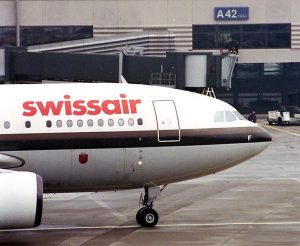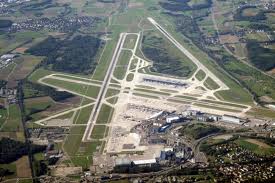All had been well until the early 1990s, when consultants McKinsey & Company recommended that the company embark on a “hunter” strategy of buying up poor-quality airlines around Europe, sorting them out with some high-quality Swiss management, and so step up into the big league of international airlines.

In the fall of 2001, a colleague and I left Kastrup airport in Copenhagen heading for San Francisco, California. We were going to attend a conference on 3D software. We had freshly printed business cards in our pockets and printouts from an early prototype of our new revolutionary software (more about this later).
The first stop was Zürich, which was the main Swissair hub, and then on to San Francisco, where we would arrive late in the afternoon local time. There would be plenty of time to go to Redwood City, check in at the hotel, have a good American dinner with a steak and a glass of cabernet sauvignon and then an early night. The conference was scheduled to start the next day.
Given that we were a start-up company we had chosen Swissair over SAS simply because of price. SAS didn’t have a direct connection from Copenhagen to San Francisco, so we had to do a stop-over someplace anyway. Swissair had the cheapest tickets. I recall a price of €500 roundtrip.
Our luggage was checked through to San Francisco and we were assigned seats by the emergency exit on the long leg of our trip (frequent flyer trick).
Leaving Copenhagen on schedule we had breakfast on board the Swissair flight to Zürich. Everything was utterly normal. Safety instructions were given, the captain made his announcements and we landed in Zurich on time welcomed by the stewardess who wished us a great day.
Arriving in Zurich

Zurich is an airport with small islands connected to the main terminal through underground tunnels. As we made our way to the main terminal we were discussing how much information on our new software we should reveal at the conference. I was in favor of being very open, but my colleague (the CTO) thought we should be more reserved.
Entering the main departure hall we were looking for the monitors announcing the gate number of the flight to San Francisco. We found the monitors and a very long day was just about to start.
All the Swissair flights were in “waiting for information” mode. Some were cancelled, but most were just in this “status unknown” state. The gate number was announced on the monitor so we started for the gate to have a chat with the Swissair staff. Arriving at the gate there we lots of passengers and no Swissair staff. We looked around to see if we could spot some Swissair representatives, but they had all vanished.
We headed for a cafe to grab a sandwich and picked up the rumours that Swissair was in financial trouble. Swissair? The Flying Bank? They couldn’t get fuel unless they paid cash in advance. Swissair executives were chasing someone who could release the cash and make the fuel flow.
No pay -> no cure.
Coming back to the gate a piece of paper had been posted on the gate door announcing that there would be an announcement at 16:00. 16:00 was AFTER our flight was supposed to leave. Not a good sign.
At 16:00 a Swissair representative opened the gate door and read the announcement. All Swissair flights were grounded and nothing could be said about if and when they would operate again. Everyone had to take care of themselves. Swissair was not in a position to help anybody with booking alternative flights or hotel accommodation. Goodbye. And gone he was.
One Man’s Death Is Another Man’s Bread

It must have been a great day for the other airlines. We all rushed to the ticket counters to get seats on other flights. After 2 hours in the line all flights from Europe to the US had departed. We had to book for the next day. Lufthansa had tickets in Economy Class: €4.000 each! I almost fainted. “How much is Business” I asked.” €5.000″. We bought 2 tickets on Economy for the next morning. We had to stopover in Frankfurt, but what the heck.
Then find a hotel for the night. Do you know the prices of hotels in Zurich? We found something affordable half an hour away and headed for the place. It was nice and clean and the hotel even had a good restaurant. We had something with rösti and “eine Stange” (a beer) and went off to get some sleep in huge Swiss duvets. Switzerland is a civilized country. How could Swissair get into such a mess?
We got to San Francisco, missed the first 1/2 day of the conference, but managed to get our message through and returned to Copenhagen with the assistance of Lufthansa.
A few days after returning we found out that Swissair did not go bankrupt but was under reconstruction. We carefully drafted a letter to the entity responsible for the reconstruction and enclosed copies of all the additional costs the incident had incurred including the new tickets we had to purchase with Lufthansa. And would you believe it: A few months later we got all the additional costs refunded and an apology as well. Swiss service at its best!
11 Years Later
A friend of mine just recently recommended to me a new book by Kim Warren titled “The Trouble with Strategy….”. Being obsessed with strategy I downloaded the book immediately and began reading. It is a interesting book, although it deals with strategy on a different level to what I do. I’ll write a review of the book in the near future.
About 14% into the book (Kindle version, loc 624) I find this statement:

“Swissair was seen by the proud Swiss nation as more than just an airline: it was symbolic of the excellence that pervaded the country’s business sector. So the grounding of its fleet in 2001 came as a shock to the entire nation. All had been well until the early 1990s, when consultants McKinsey & Company recommended that the company embark on a “hunter” strategy of buying up poor-quality airlines around Europe, sorting them out with some high-quality Swiss management, and so step up into the big league of international airlines. The company acquired stakes in a dozen airlines, some small, but other larger, such as the loss-making Belgian airline Sabena and Portugal’s TAP. All this cost vast amounts of cash, leaving the company crippled with debt. The logic of the strategy might have been reasonable enough, but when embarking on something on such a large scale that neither you nor anyone else has attempted before, you might at least expect to test the process on a small scale first, then learn and scale-up, rather than just betting the farm on its working”
Kim Warren, author of “The Trouble with Strategy…”
Although I have flown around the world more than most I do not consider myself an “airline industry expert”. I am in no position to judge whether the recommendations provided by McKinsey & Company were sober or not. However, I assume that the reason for Kim Warren deliberately and explicitly including McKinsey & Company by name must indicate that he believes they do have a share or two in the misfortune of Swissair?
He could have written: “All had been well until the early 1990s when Swissair embarked on a “hunter” strategy of buying up poor-quality…”
But he did not write so. He choose to include the McKinsey & Company name. Thus my question: Did McKinsey & Company kill Swissair?
Doing a little research I came across an article from Bloomberg Businessweek published in July 2002 titled: Inside McKinsey. Interesting reading indeed.
Strategy and Execution
I have been working with strategy for more than 30 years. The last 9 years as a management consultant. As an executive I was also intimately involved with the execution. I don’t recall any situation where strategy and execution was not an iterative process. The process goes like this: Define strategy – test – adjust strategy – test – adjust strategy – test etc. You carried on until it worked or you had to give up and try something different. The reason for this “chicken” approach was simple. None of the business units or the companies I was responsible for could afford to bet all our money on a “hole in one” implementation.
Now, there are situations where you cannot apply the “chicken” approach. If you are Apple and want to enter the smartphone market, you better get it right from the start. However, in most situations I think the “chicken” approach makes very good sense.
As a consultant, you are often excluded from the execution. You facilitate the strategy process and help identify the options. You facilitate the process of choosing the “best option” and then it is goodbye. You call back and follow up, but they don’t want you involved in the execution process. They hire the wrong people, they skip the market assessment and dive in blindfolded, they reduce the OPEX budget and increase the revenue target. Thousands of things can change or go wrong in implementation including the reality being substantially different from your assumptions. Predicting the future still remains a very difficult exercise. Especially so for management consultants.
If you use consultants to help you facilitate your strategy process, but exclude them from the implementation, then you have no right to blame them for the failure of the strategy.
As a management consultant, I have great respect for and admire McKinsey & Company. I read a lot of the stuff they publish and get inspiration from their thinking. I am working for a couple of their clients and cannot help but envy the bills they are able to generate. Clients do not keep paying that kind of money unless there is value in return. Yes, they have been involved with clients who went bust, but that is hard to avoid if you have most of the Fortune 500 as your clients.
NOVAMIND
The company that I represented en route to San Francisco was a software start-up. A venture fund had invested €1,5M in the company on the promise that the software would be able to generate 3D geometry and texture out of simple film footage. If that could be done, then it would disrupt the entire 3D industry and make 3D representation available for applications where the cost today is still prohibitive. I was hired to sort out the business plan and take the product to market.
A long story short. The software could not deliver the promised results. We managed to generate a reasonable 3D model of a Danish Pastry (Spandauer), but nothing beyond that. Failing to raise the €10M we estimated it would require to build a robust prototype, I wrapped up the company nine months later.
The strategy was unrealistic, but the execution brilliant.
This post was first published in July 2012
